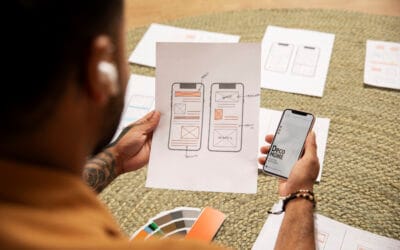In 2025, UX/UI design is evolving faster than ever. Technology continues to reshape how users interact with apps, websites, and devices, making it critical for designers to stay on top. The key focus? User-centric experiences that feel intuitive, engaging, and personalized. Let’s dive into the UX/UI design trends for 2025 and explore how these trends will shape the future of digital design.
TOP 8 UX/UI Design Trends for 2025
Years pass innovation comes in. This is how the technology transforms and brings a seamless and stunning design experience to the table. Cheers to the year 2025, where we’ll leverage these latest UX/UI design trends.
1. Multi-Device Experiences
With users seamlessly switching between phones, tablets, smartwatches, and even smart TVs, multi-device experiences are a must. Designers must create interfaces that ensure continuity, like picking up where you left off on another device.

How to Implement:
- Design with responsive layouts that adapt to different screen sizes.
- Use cloud integration to sync data and progress across devices.
- Test user flows on various devices to ensure smooth transitions.
2. Sustainable and Ethical Design
Users today care about how their choices impact the planet. In 2025, sustainable design emphasizes reducing resource usage, optimizing performance, and ethical practices.
How to Implement:
- Minimize heavy graphics or animations that consume bandwidth and energy.
- Promote ethical practices like user privacy and transparent data collection.
- Use green-friendly themes or messaging that reflects sustainability values.
3. 3D Elements & Immersive Design
3D elements and immersive experiences captivate users and make interactions more engaging. Whether its interactive 3D product showcases or gamified onboarding, this trend adds depth and excitement.
How to Implement:
- Use lightweight 3D assets optimized for fast loading times.
- Leverage tools like WebGL or Unity for immersive design.
- Introduce AR/VR compatibility for a more engaging experience, such as virtual try-ons or tours.
4. Data Visualization
In a world flooded with data, making it digestible is critical. Interactive and visually appealing data visualizations are essential for dashboards, analytics tools, and apps.
How to Implement:
- Use tools like D3.js, Chart.js, or Tableau to create customizable charts and graphs.
- Incorporate animations to highlight trends, changes, or comparisons.
- Focus on intuitive visuals, like color-coded trends or simplified infographics, to help users grasp complex information easily.
5. Personalization Powered by AI
AI-driven personalization ensures users feel understood. AI tailors the experience based on preferences, usage patterns, or even real-time emotions.
How to Implement:
- Use machine learning models to analyze user behavior.
- Customize layouts, content, and notifications to suit individual preferences.
- Provide user-friendly options for manual personalization.
6. Immersive Experiences with AR and VR
AR and VR continue to revolutionize industries, from gaming to real estate. Designers must create experiences that feel natural in these digital worlds.
How to Implement:
- Focus on spatial design, ensuring AR/VR elements align with real-world environments.
- Create onboarding tutorials to help users navigate immersive interfaces.
- Prioritize lightweight designs to ensure devices handle the experience smoothly.
7. Voice-Activated Interfaces
Voice commands are becoming second nature, and incorporating them into UX/UI designs ensures accessibility and hands-free ease.
How to Implement:
- Use voice recognition APIs like Google Speech-to-Text or Amazon Alexa Skills Kit.
- Include visual cues to guide users through voice-activated processes.
- Optimize designs to accommodate users’ accents and diverse speech patterns.
8. Sustainable Dark Mode
Dark mode continues to be a fan favorite, but now it comes with user-defined color schemes and enhanced readability.
How to Implement:
- Allow users to switch between light, dark, and customized themes.
- Test contrast ratios to ensure text is readable across all modes.
- Incorporate dark themes that align with brand identity.
FAQs on UX/UI Design Trends
How do you keep up with UI/UX design trends?
Stay updated by following design blogs, joining online communities, and attending industry conferences. Experiment with emerging tools and technologies to keep your skills sharp.
What is the future of user experience design?
The future lies in hyper-personalization, AI-driven interactions, and immersive technologies like AR/VR. Designers will focus on creating ethical, inclusive, and sustainable experiences.
What growing trends should UX designers consider when designing user experiences?
Key trends include multi-device adaptability, AI-powered personalization, and sustainable design. Accessibility and user privacy should also remain top priorities.
What do you think will be the next trend in UX design?
Adaptive interfaces that respond to real-time user emotions and preferences are likely to be the next big trend. Additionally, AI and mixed reality integrations will redefine interactive experiences.
Bottom Line!
The latest UX/UI design trends of 2025 reflect a shift toward more meaningful, sustainable, and innovative experiences. By embracing these trends, designers can craft interfaces that captivate and serve users effectively.
Willing to master the UX/UI knowledge, explore our latest insights, and subscribe to our newsletter to learn how to craft a design that stands out.



